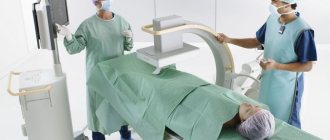Health is the most important thing a person has. There are tens of thousands of different diseases in the world, some of them have not even been studied by science. Quite often they are fraught with any consequences or complications. That is why treatment of any disease must not only be correct, but also started on time. And for this it is necessary to quickly and correctly determine the diagnosis, and it is not always possible to do this with the help of a regular survey or examination. In rare cases, a thorough diagnosis is necessary to determine the disease. It comes in different types and involves a set of procedures that reveal certain indicators of the body’s condition.
One of the most popular types of examinations today is intestinal irrigoscopy. This is a modern research method that allows you to assess the condition of the gastrointestinal tract, their condition, pathologies and dysfunction.
Irrigoscopy refers to X-ray examinations, since during it, barium liquid (a radiopaque agent) is injected into the colon using an enema, thanks to which an X-ray of the intestine is subsequently taken. This helps to determine not only the shape, size and structure of the colon, but also all sorts of pathologies in it. For example, tumors, ulcerative wounds, polyps and diverticula.
Irrigoscopy is considered a very accurate study, as it allows you to notice changes even in the folds of the intestine, that is, hard-to-reach places where usually all sorts of pathologies go unnoticed. In addition, this type of diagnosis is also relatively harmless, because the radiation dose to the colon is much less than, for example, with a computed tomography scan of the abdominal region.
What is intestinal irrigoscopy?
This is a special type of x-ray diagnostics that has been practiced in clinics relatively recently.
In this case, the object of study is the large intestine. The study identifies data on the following components of the digestive system:
- ascending colon;
- transverse colon;
- descending colon;
- sigmoid colon;
- rectum.
A special feature of irrigoscopy is that barium fluid is introduced into the body not through the oral cavity, but through the perineum. The fact is that in this procedure it is necessary that the X-ray contrast agent completely envelop the intestinal walls; if it enters through the throat, this is impossible, since the solution, passing through the larynx, pharynx, esophagus and stomach, settles on the mucous membrane of these organs, and it is practically impossible to reach the required place it comes. The perineum is a direct path to the intestines, which is why this method of drug administration was chosen.
Types of irrigoscopy
Today there are only two types of this research, namely:
- simple contrast (when a barium solution is injected into the intestine);
- double contrast (in this case, a special liquid is injected along with air).
The first type of examination is much more common than the second; it allows the doctor to clearly see the contours and condition of the walls of the colon; thanks to simple contrast, all sorts of irregularities, anomalies and intestinal defects are determined.
The second method is not used so widely, because it has many simpler replacements (for example, sigmoidoscopy, plain X-ray of the intestine). Double contrast shows inflammation and ulcerative wounds inside the lumen well.
Contraindications
Despite the undoubted benefits and informativeness of the technique, not all patients are recommended to use it for further examination. Only a doctor determines whether an X-ray of the intestine can be done.
There are the following contraindications for irrigoscopy:
- Women during pregnancy. Pregnancy is dangerous because there is a high risk of negative effects of X-ray radiation on the developing fetus;
- Decompensation of cardiovascular or pulmonary diseases;
- Severe or weakened condition of patients;
- Exacerbation of concomitant chronic diseases, which may affect the study or worsen the patient’s condition;
- High risk of perforation of the colon wall (for example, if it is severely dilated due to intestinal obstruction);
- Toxic megacolon;
- Acute inflammation of the digestive tract or anorectal area (paraproctitis);
- History of intestinal perforation and bleeding.
If there is a suspicion of nonspecific ulcerative colitis or the presence of diverticula, then irrigoscopy is possible with increased caution. The contrast solution and air are pumped at a lower pressure and low speed.
You should not unreasonably undergo X-ray diagnostics at your own request, because exposure to ionizing radiation can also have negative consequences for human health.
Only a doctor can determine how often irrigoscopy can be done, taking into account the balance of benefits and risks for a particular patient.
Why do this research?
Irrigoscopy of the colon is a fairly common type of examination; it is often prescribed by gastroenterologists.
This procedure has gained popularity due to its accuracy and ease of implementation. In addition to the fact that it is less harmful than other similar examinations, irrigoscopy is also painless and any injuries rarely occur after it.
Since this procedure accurately identifies many abnormalities and pathologies, it accordingly identifies most diseases, which, if left unchecked, can lead to a huge number of complications.
So, this type of research is done in order to:
- verify the suspected diagnosis of colon disease;
- determine whether there are tumors, polyps and diverticula and where they are located;
- assess the relief of the inner wall of the colon, detect various ulcers and dead areas of the dermis;
- identify and analyze all kinds of disturbances in the functioning of the colon;
- study the peculiarities of the functioning of the intestines, the nature of the occurrence of spasms and atony.
The diagnostic results are compared with the normal values observed during the same procedure in healthy people. The following conclusion is considered a good result of irrigoscopy:
- the shape, size and location of the colon are absolutely appropriate for the age category;
- the intestinal walls are stretchable and elastic over the entire area of the organ;
- the relief of the internal walls is normal, has some circular protrusions within normal limits;
- The baugin layer performs its function by not allowing contrast agents to pass into the area of the small intestine.
Interesting! The relief of the inner wall of the intestine can be of two types, and both of them are absolutely normal. The first is a calm relief, smoothed folds are observed at a large distance from each other, and the second is excited. The latter is manifested by pronounced deep folds, which are very close to each other.
Indications for examination
As a separate study, irrigoscopy is prescribed extremely rarely when certain symptoms occur. Before this type of diagnosis, the patient usually undergoes a series of tests and, if necessary, undergoes several other examinations. Their results are indications for an additional type of diagnosis - irrigoscopy.
So, you are likely to be prescribed this form of examination if:
- There is the presence of blood, purulent discharge and mucus in the stool. During diagnosis, defects and abnormalities on the inner wall of the colon are examined, usually these are ulcers and diverticula. It is also possible to detect polyps (bulging areas that look like mushroom caps) and inflamed infiltrates (look like a lump on the mucous membrane).
- There is frequent pain in the perineum and anal area, especially during bowel movements. Irrigoscopy identifies various pathologies and formations on the intestinal walls that cause inflammation and spasms.
- There is a suspicion of a malignant tumor, in other words, colon cancer. On x-ray it appears as a round formation, which has a smooth surface; erosion is rarely observed.
- A diagnosis of acute intestinal obstruction was made. In this case, an examination is used to identify the place of greatest narrowing of the intestine, which appears due to the presence of a kink, scars or a pinched loop.
- There is constant diarrhea or constipation. With increased tone of the colon, disorders occur; on an x-ray, this is manifested as a narrowing of the passage and a folded surface of the walls. But constipation, on the contrary, is revealed by smooth mucosa and a wide lumen.
If you experience any of the above symptoms, consult your doctor immediately, as this may be evidence of a serious illness that needs to be identified and treated.
Indications and contraindications
Intestinal irrigoscopy is indicated in the following cases:
- cicatricial adhesive processes that arose after surgery or against the background of protracted inflammatory processes;
- single or multiple pathological protrusions of the intestinal walls (diverticula);
- intestinal fistulas;
- chronic inflammatory processes;
- significant enlargement of the entire large intestine or a separate part of it;
- the length of the sigmoid colon is more than 46 cm;
- frequent abdominal pain of unknown etiology;
- stable stool disorders (constipation or diarrhea);
- monitoring the condition of the intestine after resection;
- detection of blood streaks in stool;
- assessment of the condition of surgical anastomoses between intestinal walls.
This method becomes very relevant if for some reason a colonoscopy cannot be performed or if the results it gives seem questionable. In addition, such a diagnosis is mandatory if cancer is suspected in a patient with poor heredity or in those who are being seen by an oncologist.
Contraindications to irrigoscopy are not numerous, but they do exist: the patient’s general serious condition caused by cardiac or respiratory failure, penetrating damage to the wall of the large intestine, pregnancy, acute inflammatory processes in the intestine. Before prescribing irrigoscopy, the proctologist must weigh all contraindications and come to the conclusion that the likely benefit, in the case of a particular patient, outweighs the possible risk.
What will irrigoscopy show?
This type of examination is very accurate and almost always indicates the presence of the correct disease. But a lot also depends on the qualifications of the specialist who is caring for the patient. So, with the help of irrigoscopy you can detect the following diseases:
- Irritable bowel syndrome (refers to disorders of the functional functioning of the intestine). On x-rays it appears as uneven folds, as different parts of the intestine are strained differently during work. The bowel movement does not occur completely; the contrast agent remains inside, since the coordination of the colon is impaired. Constrictions in some places are also visible, which are caused by spasms.
- Chronic colitis is observed by various lumens in the colon, which appear due to improper contraction of smooth muscles in the organ. The lumen narrows due to frequent spasms, a large number of inflammations appear on the walls, which contract unevenly, and folds are clearly visible.
- Ulcerative colitis. The mucous membrane has many small spots, ulcerative wounds and dead areas of tissue. The so-called “pseudopolyps”, which appear due to scarring of the tissue, are clearly visible. The intestinal lumen either narrows or expands (not in all cases).
- Diverticulosis is manifested by an uneven relief of the intestine; large and small diverticula are present on the walls, along with which infiltrates often appear, which reduce the elasticity and extensibility of the dermis.
- Bowel cancer. Small round-shaped formations are visible on the walls, and the appearance of rings (polypoid carcinomas), which are the contours of neoplasms, is also possible. As a rule, there are no folds in these places.
- An intestinal polyp appears as a round or pointed neoplasm on the mucosa, which sometimes has a stalk.
Why is irrigoscopy needed?
If there is a need for an X-ray examination of the large intestine, irrigoscopy is used.
During the diagnosis, the doctor observes the progress of the contrast agent through the intestinal area. Depending on what substance will show gaps or slightly darkened areas, this will help establish the condition of the colon and determine whether there are foreign bodies, neoplasms or polyps in it.
A barium enema will help determine the shape and taper of the colon and how it moves over time.
The large intestine is characterized by one feature that distinguishes it from other parts of the digestive tract - it has a haustrum, that is, an expansion of the intestinal section (tube), divided into segments. The largest number of haustra is located in the transverse colon.
Irrigoscopy is able to determine how the location, length and sections of the sigmoid colon, which is characterized by the greatest mobility among other intestines, changes. This study also helps to establish the presence and nature of the mucosal folds covering the inside of the large intestine; other folds (longitudinal and transverse) are also diagnosed during irrigoscopy.
This type of research is crucial in the diagnosis of tumors, diverticulosis, and ulcerative lesions. Irrigoscopy is also used to monitor the activity of intestinal contractions and to study cicatricial narrowings and congenital anomalies of the large intestine. This procedure is non-traumatic, painless, and in terms of radiation exposure it is less intense than computed tomography.
Preparation for intestinal irrigoscopy
In order for the results of the study to be as accurate as possible, it is necessary to take care of this in advance, that is, prepare for the procedure. First of all, it is necessary to thoroughly cleanse the intestines. This is usually done by taking medication, namely Fortrans. This is a powder that must be diluted with warm water and start drinking 1 glass every 15 minutes 5-6 hours before the examination. Naturally, eating at this time is strictly prohibited. Only natural liquids (water, juice, broth) are allowed.
A safer and, for some, enjoyable option is a regular cleansing enema. They are usually done in the evening the day before the procedure, breakfast is allowed in the morning, and immediately before irrigoscopy, 2 more enemas based on warm purified water are used. But it is also worth remembering that in this case it is necessary to adhere to a diet, namely, exclude potatoes, rice porridge, flour products, fresh vegetables and dairy products from the menu.
When preparing for irrigoscopy, you can also use the method of colon hydrotherapy, which is carried out only in the clinic. This is also an intestinal lavage, but with much more water.
You also need to prepare personal items that will be needed during the research, namely this:
- slippers;
- nightie;
- robe;
- a sheet (two if necessary);
- bath accessories for showering after the procedure.
Using the above rules, you can easily undergo irrigation and get accurate results.
How is irrigoscopy performed?
Irrigoscopy at SM-Clinic is as comfortable as possible for the patient.
You lie down on the couch, using a special nozzle, a specialist, under the control of images, injects a barium sulfate solution heated to 33-35 degrees through the rectum. After contrast is introduced, photographs are taken in various projections.
The mixture is eliminated in one trip to the toilet. With double contrast, a second examination is performed immediately after bowel movement: air is introduced through the rectum using a special nozzle and a series of radiographs are taken.
The duration (from 15 minutes to 1 hour) depends on the parts of the intestine being examined and the need for double contrast.
At SM-Clinic, each patient is given as much time as needed.
Contraindications for the study
In some cases, doctors prohibit patients from performing irrigoscopy and choose an alternative option. This is most often done in case of pregnancy, since the radiation can affect the baby. This procedure is also prohibited for heart disease, because a stressful situation may arise, which will put a strain on the cardiovascular system and can even cause a heart attack.
- The test is positive, but the ultrasound does not show pregnancy
- PET CT
- Is MRI harmful?
- Gastroscopy of the stomach and alternative methods...
- Standards for screening in the second trimester of pregnancy.










